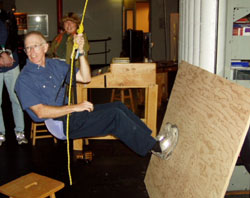
Experience the feel of reduced gravity using an inclined plane.
Climbing in low gravity
Rock climbing uses human muscle and bone to oppose gravity and ascend rock and ice.
Let's examine the gravity, rock and ice on Mars.
Gravity
On Mars you weigh 1/3 of what you weigh on Earth. (More precisely you weigh 0.37 what you weigh on earth.) If I weight 150 pounds on earth then I weigh 56 pounds on Mars.
On Mars, even I can do a 1 arm pull up.
Activity: Marswalk, Use the Mars swing-set to do pull ups.

Experience the feel of reduced gravity using an inclined
plane.
The Mars swing set. If you have a swing set you can feel what it is like to be on Mars.
Simply build an inclined plane under the swingset.
Falling
You can also experience freefall under Martian gravity using an Atwoods machine.
I atached a baseball to a thin rope which ran over one pulley then a second puley and dropped down to a half a baseball. If the rope and pulley wheels were massless then the baseball would fall at 1/3 g. This means that when I drop the Mars baseball next to a free baseball the Mars baseball would fall 1/3 as far as the earth ball in the same time interval.
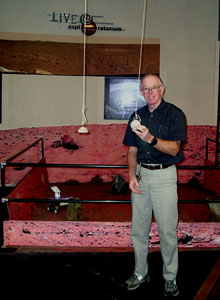
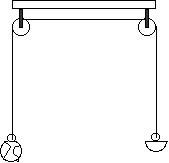
A drawing of the Martian baseball machine.
Go here for
details on how to build it.
When I did the experiment the Mars baseball fell with too little acceleration, I figured that I didn't have massless string and massless pulley weels, so I added 6 ounces of lead sinker weights to the baseball until it fell at Mars acceleration.

Since you can fall with good energy absorbing style from 16 feet on earth without injury, you could fall thee times as far under the 1/3 g acceleration on Mars with the same, no injury, result. That means you could fall off the top of a boulder on Mars as high as the roof of the Exploratorium and land without injury.
The Rock
The rock of Mars is mostly volcanic, basalt and maybe andesite.
There is be good climbing on basaltic and andesitic rocks on earth.
There are basalt cliffs on the shore of Lake superior, east of Duluth, and in many other places.
Basalt often cools and cracks with columnar jointing. Like the cracks on the surface of Devil's Tower Wyoming. Climbers climb these cracks.

Basalt also has gas bubbles which make holes known as vesicles. Climbers can insert fingers and toes into vesicles and use these holes to pull themselves up rock faces. We can see vesicles on many of the rocks near the pathfinder lander.
There are large lava tubes on Mars, some
collapsed, good climbing is found on lava tube walls on earth.
There are also giant canyons such as Valles Marineris, a canyon system so large that the Grand Canyon on Earth would only be a minor tributary. In fact Valles Marineris would stretch from one cost of the United States to the other. The walls of Valles Marineris are lava flows, not sandstones or limestones which form the walls of the Grand Canyon. Large basalt lava flows contract when they cool producing numerous vertical fractures which might make them perfect for climbing. Photographs of Mars have not shown the columnar fractures in the basalts of Mars but I am confident in my prediction that they will be found.
There is another set of fractures on Mars named Cerberus Fossae. these are a set of deep fractures into lava flows which produce vertical cliffs that may also provide good climbing, they will at least provide good slot canyons to explore.
There are some steep, eroded rock faces on Mars, reminiscent of the cliffs in Monument Valley, Utah. These may or may not be good for climbing, but the scenery should be spectacular.
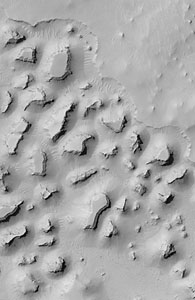
The surface of Mars is about as big as the land surface of earth. (Mars is 100% land but it is only 1/2 the diameter of earth so it has 1/4 the surface area of earth. While the earth is 1/3 land 2/3 water.)
Activity: show balls with relative sizes of earth and Mars, for example an 8 inch (20 cm) diameter Styrofoam ball and a 4 inch (10 cm) diameter ball.
We still haven't seen the equal to Yosemite on Mars.
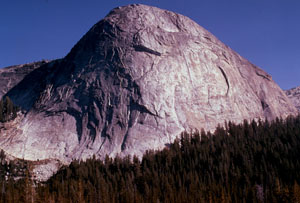
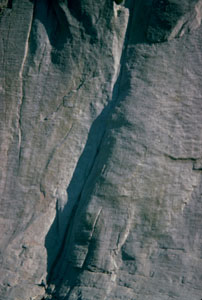
Pressure and Oxygen
Climbers would need to wear a pressure suit, and carry oxygen. The atmospheric pressure on Mars averages 6 millibars, 6 thousandths the atmospheric pressure of earth, equal to the atmospheric pressure on earth at 115,000 feet above sea level. People cannot breathe without additional oxygen above 30,000 feet. Even breathing pure oxygen is not enough above 46,000 feet. For flights above 38,000 feet pilots "pressure breathe, that is, pure oxygen is forced into their lungs under pressure, this pressure would blow them apart unless they were squeezed inward by wearing a pressure suit. Pilots need a pressure suit above 63,000 feet for an additional reason, their blood would boil at body temperature if they were exposed to the ambient air pressures at these altitudes. On all of Mars the pressure is so low human blood would boil unless the person were protected by a pressure suit.
Mountaineering

The highest mountain in the solar system is on Mars, it is Olympus Mons which rises 21 km above the Mars reference altitude. It is about 70,000 feet high or two-and-a-half times as high as Mount Everest (measured at 29,000 feet, or about 9 km, above sea level) It rises 18 km or 60,000 feet over the highlands that surround it.
Olympus Mons is an easy walk-up just like the shield volcanos of Hawaii. It was built of fluid lava, which does not pile up like the ash on stratovolcanos.
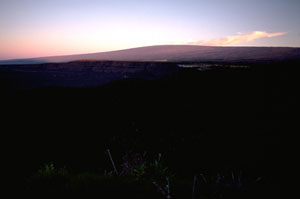
It is 330 miles across so it has a very gentle slope for a mountain climber rising 400 feet per mile. However for a road this so-called 8% grade seems very steep, so bicycling up Olympus Mons would be hard work even with the reduced Mars gravity. Many streets in San Francisco have a grade steeper than 8 %. The volcano is surrounded by a steep cliff band, one kilometer, or three thousand feet, high which might provide more interesting climbing.
Ice

Ice is piled high on the polar caps of Mars. There are ice cliffs on the edge of the polar plateau, so ice climbers can have fun.
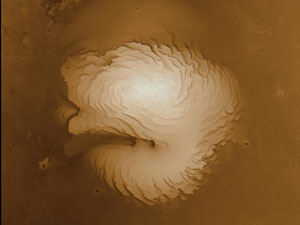
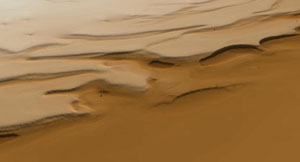
Many ice cliffs are found on the edges of the North polar cap.
The ice is both water ice and carbon dioxide ice, a.k.a. dry ice.
Boulders
One of the purest forms of climbing is bouldering, where a climber without a rope or other gear for protection uses just hands and feet to ascend a rock.
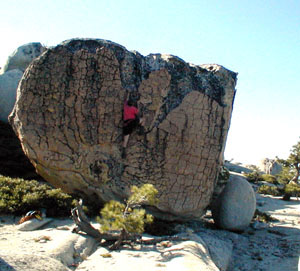
There are large boulders on Mars. Due to the low gravity climbers can ascend three times higher than on earth. So if I'm willing to climb a boulder 16 feet high on earth, then on Mars I can climb a 50 foot high boulder and risk the same injury.
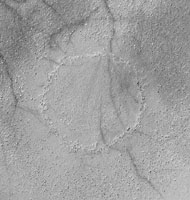
Even better boulders can be found on the moons of Mars where the gravity force is tiny, 1/1500 of the acceleration of gravity on Earth. So on Phobos I would weigh 1/10 of a pound. A tenth the weight of a pint of beer!
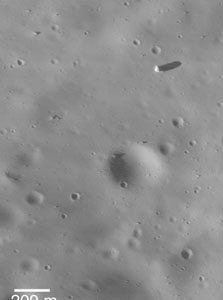
Sunblock
Climbers need factor 100 sunblock on Mars to replace the shielding of earth's ozone layer. Mars has no ultraviolet shielding. And, Mars is 1.5 times further from the sun so the UV dose is reduced buy the inverse square of this distance, that is by a half. The earth's ozone layer is factor 256 sunblock. The combination of these two affects leads to the need for factor 100 sunblock. Of course, on earth I need factor 50 sunblock at high desert locations near the equator on earth, in addition to the ozone layer, so on Mars I'd need factor 5000 sunblock.
Rappelling
Climbers descend from cliffs by rappeling, sliding down their ropes back to the ground.
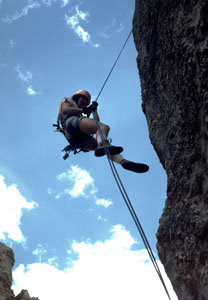
One Mars exploring spacecraft is designed to rappel down the cliffs of Mars, to analyze the layers of rock as it goes down.
I began my lecture with the latest image from Mars
The latest image from Mars is a 3-d image showing a nearby depression, probably a crater, named "Sleepy Hollow."
There is not much in this image to interest a rock climber. There is a range of mountains in the distance, perhaps they have some good climbing cliffs?
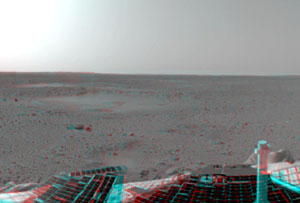
|
Scientific Explorations with Paul Doherty |
|
25 Dec 2003 |